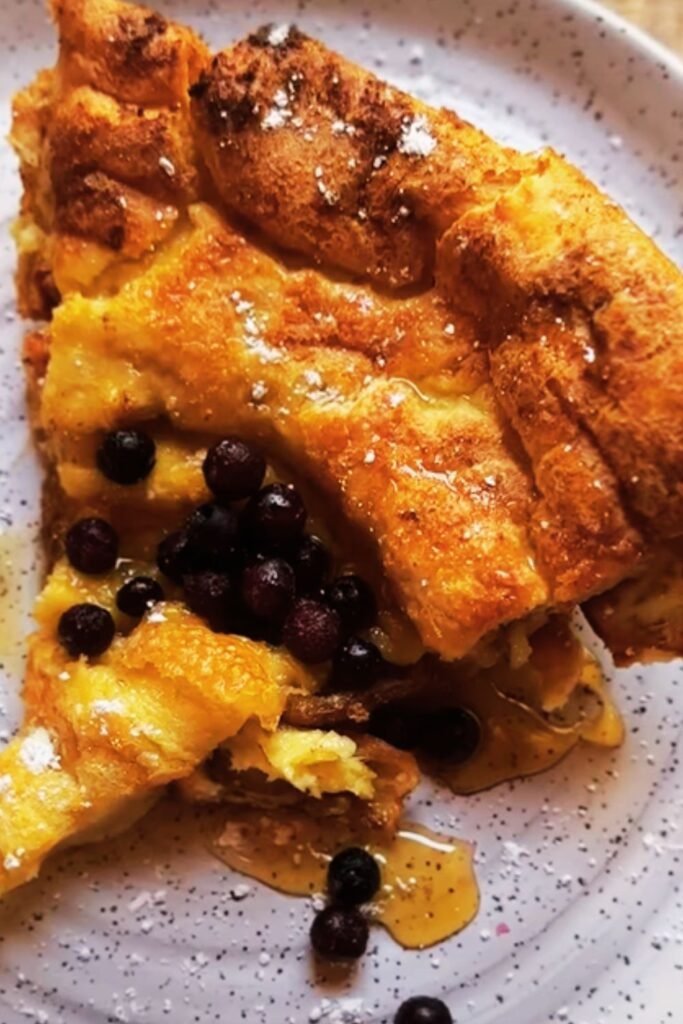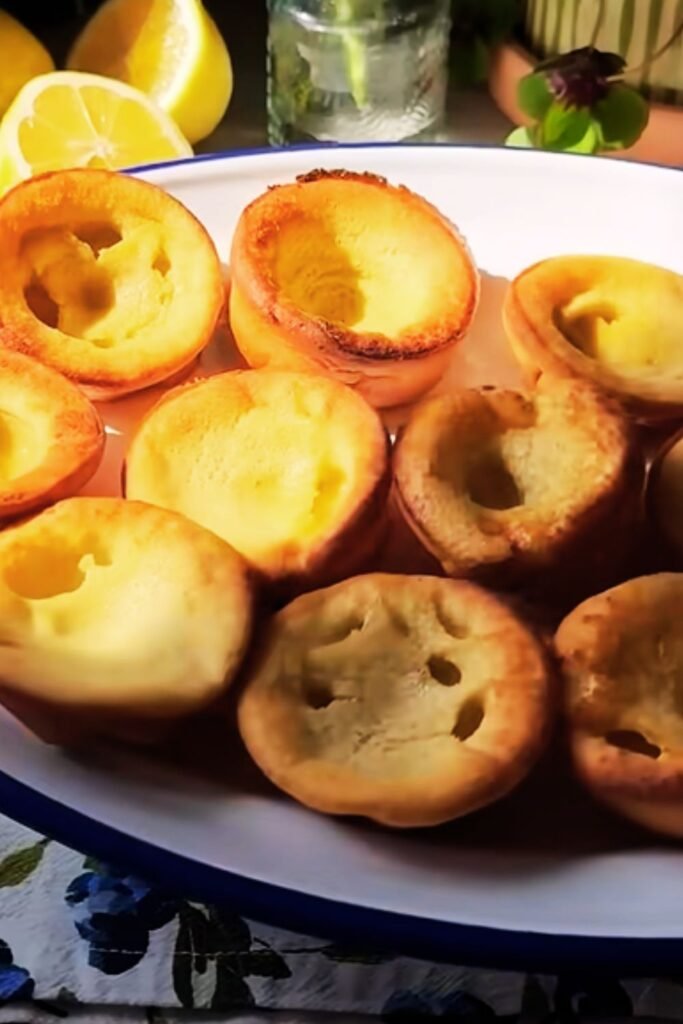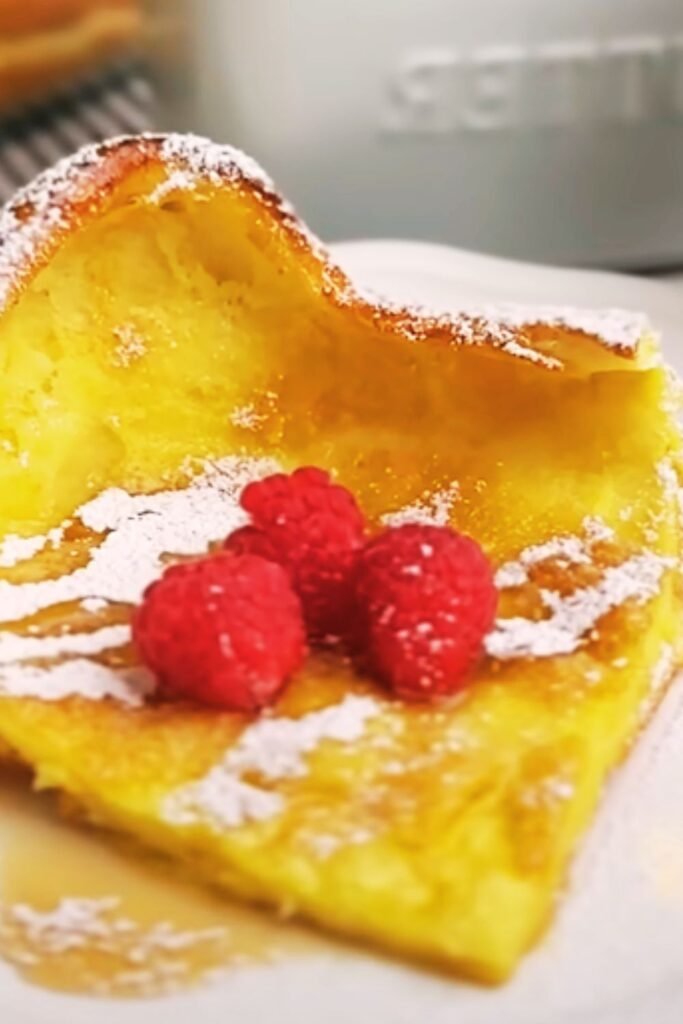There’s something magical about pulling a perfectly puffed German pancake from the oven. The way it rises dramatically around the edges, creating a golden crater ready to be filled with your favorite toppings, never fails to impress both family and guests. I’ve been making these delightful breakfast treats for years, and they remain one of my most requested brunch items.
Also known as Dutch babies or Bismarcks, German pancakes are essentially a large, baked popover-like pancake that’s crispy on the outside and tender on the inside. Unlike traditional pancakes that require standing over a stove flipping individual portions, German pancakes bake entirely in the oven—making them perfect for feeding a crowd with minimal effort.
In this article, I’ll share my tried-and-true recipe for creating the perfect German pancake, along with tips, variations, and serving suggestions that will elevate your breakfast or brunch game to new heights.
What Makes German Pancakes Special?
German pancakes differ from regular pancakes in several important ways:
- They’re baked in the oven rather than cooked on a stovetop
- The batter contains more eggs, creating a custard-like interior
- They puff dramatically while baking, then collapse when removed from the oven
- One large pancake serves multiple people
- The texture combines crispy edges with a tender center
The origins of German pancakes are somewhat disputed. While the name suggests German roots, many food historians believe they’re actually an American creation inspired by German Pfannkuchen or Dutch pannekoeken. Whatever their true lineage, they’ve become a beloved breakfast tradition in many American households.
Perfect German Pancake Ingredients
The beauty of German pancakes lies in their simplicity. You likely already have everything you need in your pantry and refrigerator. Here’s what you’ll need:
| Ingredient | Amount | Notes |
|---|---|---|
| Large eggs | 4 | Room temperature for better rising |
| All-purpose flour | 1 cup (120g) | Unbleached preferred but not required |
| Milk | 1 cup (240ml) | Whole milk creates the richest texture |
| Granulated sugar | 2 tablespoons | Adds slight sweetness without overwhelming |
| Pure vanilla extract | 1 teaspoon | Use real extract, not imitation |
| Salt | ¼ teaspoon | Enhances flavor |
| Butter | 4 tablespoons (56g) | For the pan; unsalted preferred |
| Powdered sugar | For dusting | Optional but traditional |
| Fresh fruit | For serving | Berries, sliced peaches, or sautéed apples work well |
| Lemon wedges | For serving | The traditional accompaniment |
| Maple syrup | For serving | Pure maple syrup recommended |
Essential Equipment
While German pancakes don’t require specialized tools, having the right equipment ensures success:
- 10-12 inch cast iron skillet (preferred) or oven-safe skillet
- Blender or mixing bowl with whisk
- Measuring cups and spoons
- Spatula
- Oven mitts
- Fine mesh sieve for dusting with powdered sugar

Step-by-Step German Pancake Recipe
Preparation
- Place your cast iron skillet in the oven and preheat to 425°F (220°C). Heating the skillet is crucial for getting that dramatic puff.
- Gather all ingredients and let eggs and milk come to room temperature if possible.
Make the Batter
- In a blender, combine the eggs, milk, flour, sugar, vanilla extract, and salt.
- Blend on medium speed for about 30 seconds, until the mixture is smooth and free of lumps.
- Let the batter rest for 10-15 minutes if time allows. This helps the flour hydrate and results in a tenderer pancake.
Prepare the Pan
- When the oven is fully preheated, carefully remove the hot skillet using oven mitts.
- Add the butter to the hot pan and swirl until fully melted and starting to foam slightly.
- Immediately pour the batter into the hot, buttered skillet. The batter should sizzle when it hits the pan—this is a good sign!
Bake to Perfection
- Quickly return the skillet to the oven and bake for 20-25 minutes.
- Do not open the oven door during the first 15 minutes of baking, as temperature fluctuations can cause your pancake to fall.
- The pancake is done when it’s puffed dramatically around the edges and golden brown across the surface.
Serve With Flair
- Remove from the oven—be prepared for oohs and aahs as you bring it to the table.
- The pancake will begin to deflate almost immediately after removal from the oven—this is completely normal.
- Dust with powdered sugar through a fine-mesh sieve.
- Add your choice of toppings and serve immediately while still warm.

My Pro Tips for German Pancake Success
After years of making German pancakes, I’ve discovered several tricks that make a significant difference:
Temperature Matters
Room temperature ingredients create a better rise. If you’re in a hurry, place cold eggs in warm (not hot) water for 5 minutes and microwave the milk for 20 seconds to take the chill off.
The Power of Preheating
Never skip preheating the pan. The hot pan and sizzling butter create the steam that helps the pancake rise dramatically.
Blender Advantage
While you can whisk the batter by hand, using a blender incorporates more air and creates a smoother texture. If mixing by hand, be thorough but don’t overmix—stop when you no longer see lumps.
Rest If You Can
Allowing the batter to rest for 10-15 minutes gives the flour time to hydrate properly and the gluten to relax. This results in a tenderer pancake.
Don’t Peek!
Resist the urge to open the oven door during baking, especially during the first 15 minutes. The sudden temperature change can cause your beautifully rising pancake to collapse prematurely.
Cast Iron Is King
While any oven-safe skillet works, cast iron produces the most dramatic rise and the crispiest edges due to its excellent heat retention.
Delicious Variations to Try
The classic German pancake is wonderful, but don’t be afraid to experiment with these tasty variations:
Apple German Pancake
Before pouring in the batter, sauté 1-2 thinly sliced apples with 2 tablespoons of butter, 1 tablespoon of brown sugar, and ½ teaspoon of cinnamon in the hot skillet. Pour the batter over the apples and bake as directed.
Blueberry Lemon
Add 1 tablespoon of fresh lemon zest to the batter. After pouring the batter into the skillet, sprinkle 1 cup of fresh blueberries over the top before baking.
Savory Version
Omit the sugar and vanilla, and add ¼ cup of grated Parmesan cheese and 1 tablespoon of chopped fresh herbs (rosemary, thyme, or chives work well). Top the baked pancake with sautéed mushrooms and spinach.
Chocolate Lover’s
Add 2 tablespoons of unsweetened cocoa powder to the batter. Serve with chocolate chips, sliced strawberries, and a dollop of whipped cream.
Mini German Pancakes
Divide the butter and batter between the cups of a muffin tin. Bake at 400°F (205°C) for about 15 minutes for individual-sized pancakes perfect for a buffet.
Perfect Toppings and Serving Suggestions
The best part about German pancakes is how versatile they are when it comes to toppings. Here are some of my favorite ways to serve them:
Classic Style
A simple squeeze of fresh lemon juice and a generous dusting of powdered sugar is traditional and delicious in its simplicity.
Fresh Fruit Medley
Top with a colorful mix of fresh berries, sliced banana, and a dollop of vanilla yogurt for a breakfast that’s as beautiful as it is nutritious.
Maple Cinnamon
Drizzle with pure maple syrup and sprinkle with cinnamon sugar for a comforting, classic flavor combination.
Nutella & Banana
Spread a thin layer of Nutella on the warm pancake and top with sliced bananas and chopped hazelnuts.
Apple Compote
Top with warm apple compote (diced apples cooked with a bit of butter, cinnamon, and brown sugar) for a cozy fall breakfast.
Citrus Burst
Segment oranges, grapefruits, and blood oranges. Arrange over the pancake and drizzle with honey and a sprinkle of fresh mint.
Nutritional Benefits
German pancakes can actually be part of a balanced breakfast, especially when topped thoughtfully:
| Nutrient | Amount Per Serving* | % Daily Value | Benefits |
|---|---|---|---|
| Protein | 8g | 16% | From eggs; supports muscle health |
| Calcium | 120mg | 12% | From milk; supports bone health |
| Iron | 2mg | 11% | From flour; supports blood health |
| Vitamin A | 400IU | 8% | From eggs and butter; supports eye health |
| Vitamin D | 45IU | 11% | From eggs; supports bone health |
| Calories | Approximately 250 | – | Per serving without toppings |
*Based on recipe serving 4 people
When topped with fresh fruits, you’ll add essential vitamins, fiber, and antioxidants to your meal.

Make-Ahead and Storage Tips
While German pancakes are best enjoyed fresh from the oven, here’s how to manage leftovers or prepare components ahead of time:
Make-Ahead Options
- Prepare the batter up to 24 hours in advance and store in a covered container in the refrigerator. Just be sure to bring it to room temperature and whisk well before baking.
- Measure out dry ingredients the night before to streamline your morning prep.
Storage Solutions
- Store leftover German pancake in an airtight container in the refrigerator for up to 2 days.
- Reheat individual portions in a 350°F (175°C) oven for 5 minutes or in a toaster oven until warm.
- While microwaving is convenient, it will make the pancake soggy rather than crisp.
Freezing Instructions
- German pancakes can be frozen after baking. Cut into portions, wrap tightly in plastic wrap, then foil, and freeze for up to 1 month.
- Thaw overnight in the refrigerator and reheat in a 350°F (175°C) oven for 8-10 minutes until warm and slightly crisp again.
Why Your German Pancake Might Not Rise: Troubleshooting
If your German pancake doesn’t puff up as dramatically as expected, consider these possible causes:
- Oven not hot enough: Make sure your oven is fully preheated.
- Cold ingredients: Room temperature eggs and milk create better lift.
- Pan not hot enough: The skillet needs to be scorching hot when you add the batter.
- Opening the oven door: This causes temperature fluctuation that can deflate your pancake.
- Old baking ingredients: Check that your flour isn’t too old as this can affect rising.
- Overmixing: This can develop too much gluten, making the pancake less likely to rise properly.
Perfect Occasions for German Pancakes
I find German pancakes are ideal for so many occasions:
- Weekend family breakfasts
- Holiday morning meals
- Brunch parties
- Birthday breakfast celebrations
- Breakfast-for-dinner nights
- Impressing overnight guests
Part of their appeal is the dramatic presentation—bringing a puffed, golden pancake straight from oven to table creates a memorable dining experience.
Frequently Asked Questions
Q: Why is my German pancake not puffing up? A: The most common reasons are not preheating the pan enough, using cold ingredients, or opening the oven door too early. Make sure your pan is hot, your ingredients are at room temperature, and you don’t peek during the first 15 minutes of baking.
Q: Can I make German pancakes without a cast iron skillet? A: Yes, any oven-safe skillet will work, though cast iron delivers the best results. In a pinch, you can use a pie plate or cake pan, but the pancake may not rise quite as dramatically.
Q: Is a German pancake the same as a Dutch baby? A: Yes, they’re essentially the same dish with different names. You might also hear them called Bismarcks, Dutch puffs, or oven pancakes.
Q: Can I make this recipe dairy-free? A: Yes, substitute plant-based milk (almond or oat work well) and use coconut oil instead of butter. The pancake won’t taste exactly the same but will still be delicious.
Q: Why does my German pancake deflate so quickly? A: This is completely normal! The dramatic puff is caused by steam, which escapes when the pancake is removed from the oven, causing it to deflate. This doesn’t affect the flavor or texture.
Q: Can I make a savory German pancake? A: Absolutely! Omit the sugar and vanilla, add herbs to the batter, and top with savory ingredients like sautéed vegetables, cheese, or even smoked salmon.
Q: How many people does one German pancake serve? A: A standard 10-12 inch pancake typically serves 4 people as a main dish, or 6 people as part of a larger brunch spread.
Final Thoughts
German pancakes have earned their place as a breakfast favorite in my home for good reason. They combine ease of preparation with impressive presentation, versatility, and delicious flavor. Unlike regular pancakes that keep you tied to the stove, German pancakes bake while you prepare the rest of your meal or simply enjoy your morning coffee.
What I love most about this recipe is how it brings people together. There’s something about carrying that puffed golden creation to the table that creates a sense of occasion, even on an ordinary weekend morning. As the pancake deflates and is divided among plates, conversations flow and memories are made.
Whether you’re new to German pancakes or they’re already a family tradition, I hope these tips and variations inspire you to make them part of your breakfast repertoire. With minimal ingredients and effort, you can create a breakfast that feels special enough for celebrations yet simple enough for everyday enjoyment.
So heat up that skillet, whip up that simple batter, and prepare to watch the magic happen in your oven. Your brunch game will never be the same again!